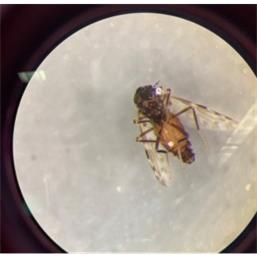OAHN Network Project: Identification of Culicoides species found in selected areas of Ontario from June – September 2022

Project Lead: Dr. Katie Clow
Collaborators: Valentina Rodriguez
Background

Photo credit: Valentina Gonzalez Rodriguez
Culicoides spp. are a genus of biting midges that are important vectors of several viruses, including bluetongue virus (BTV) and epizootic hemorrhagic disease virus (EHDV) in ruminants. Ontario has many native Culicoides spp. which are not competent vectors of these viruses. However, the recent detection of these viruses in previously unreported areas of Ontario, Canada, suggests the possibility of a northward expansion of new species of Culicoides. BTV serotype 13 was detected in cattle in 2015 and EHDV detected in deer in 2017 and 2021. These changes warrant increased surveillance of these species to identify potential changes in disease risk to wild and domestic ruminant populations. The objective of this project was to describe spatial and temporal patterns of Culicoides spp in select areas of Ontario that have not been previously sampled.
Research Design
In this study, field sampling was conducted at 9 selected sites in Ontario, consisting of ovine, bovine, and equine farms. Two ultraviolet blacklight traps were set up on each premises and run for three consecutive nights every other week from June to September 2022. Trap collections were preserved in a salt solution and then Culicoides spp. were separated from bycatch in the laboratory and stored in 95% ethanol. A subset of samples were morphologically identified using a stereoscope and identification keys. The remaining collections were classified using the environmental DNA (eDNA) in the ethanol preservation solution with high-throughput sequencing targeting the cytochrome oxidase subunit 1 (COI) gene. Spatial analysis was conducted to examine the distribution of 3 different Culicoides species of interest.
Results
A diversity of Culicoides spp. were detected across the farms during the sampling time frame. Culicoides subgenus Avaritia was detected on all premises. This subgenus includes three species that have been confirmed as vectors for BTV in Europe. Further molecular differentiation of a subset of samples confirmed the presence of these three species; C. chiopterus was found on one premises, C. obsoletus on all premises, and C. sanguisuga on four premises. Subgenus Monoculicoides was detected on seven premises. This subgenus includes the known vector species for BTV and EHDV, C. sonorensis. Presence of C. sonorensis was confirmed via molecular methods at 2 premises, one in central Ontario and one in eastern Ontario. Culicoides stellifer is suspected to be a vector for both BTV and EHDV and was detected on all premises.
This study highlights that Culicoides spp. of animal health concern are present in the province in several areas. Given minimal previous surveillance, it is challenging to contextualize these findings. Longitudinal monitoring across areas of southern and eastern Ontario for Culicoides spp. would greatly enhance our ability to monitor changes in the vector population and assess the risk to animal health.

